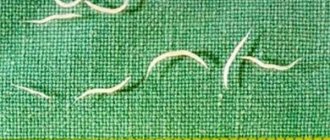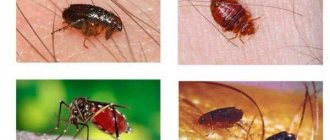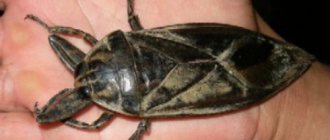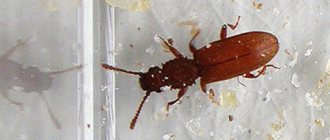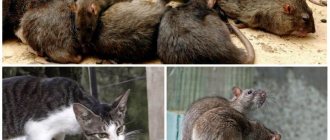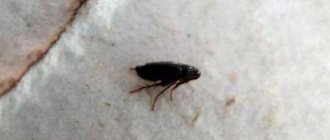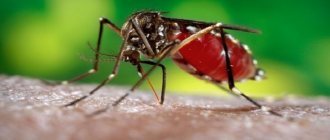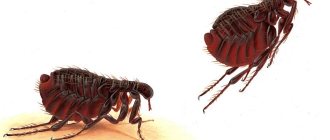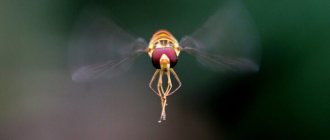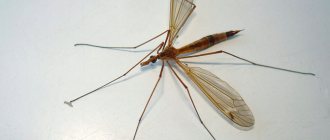It happens that at night someone begins to bite a person in his own bed. The first thought is: “Bedbugs!” Indeed, these harmful insects cause significant damage to both the physical and mental health of a person. If they multiply greatly, you can forget about normal sleep, and itching, redness of the skin and pain at the site of the bites will become familiar. But there are other insects that can bite in bed at night, besides bedbugs. There are quite a lot of such parasites, and the only good thing is that it’s easier to get rid of them, compared to bedbugs.
Blood-sucking bugs
Blood-sucking bedbugs are the only insects listed here that literally live in beds, sofas, bedding, and the folds of mattresses and pillows.
- The size of bedbugs most often varies between 5–7 millimeters, the bodies of females are rounded, those of males are more elongated, the color is brown, copper, or reddish-brown.
- The larvae look like smaller versions of adult bedbugs, but are lighter in color and smaller in size.
- Bed bugs leave behind a brown, corrosive dirt that is easy to find in places where insects accumulate.
- Bite marks look like swollen red dots, which always appear in several pieces and line up in a chain.
- When bugs puncture the skin, they inject an anesthetic into it, so the moment of the bite may not be felt; in larvae, this body system is underdeveloped, so their bites, on the contrary, can be painful.
In Moscow and the Moscow region, two types of bed bugs are found in apartments - bed
(Cimex lectularius) and
tropical ones
(Cimex hemipterus). If you do not take into account extreme situations, when the number of insects in the room is close to catastrophic, then bed bugs will bite mainly at night, tropical ones - during the day.
Recommended Links
The reasons for the appearance of bedbugs in the bed, methods of searching for them, characteristic signs of their presence and methods of destruction.
Fleas
A person can be bitten by several types of fleas
and all of them are carriers of parasites and various diseases, from helminthiases to plague, borreliosis and various types of typhus.
- The size of fleas living in the Central region of Russia usually varies between 0.5–3 millimeters, so the insects look mostly like dark moving dots.
- A flea bite always feels like a sharp, burning pain at the site of the skin puncture.
- A small, hard, dried drop of blood may remain at the site of the bite.
- Insects are not particularly scrupulous in choosing a place on the body to feed on, so they can bite in any open areas of the skin.
- The flea bite begins to itch instantly and itch severely for several days.
Fleas do not tend to gather en masse to nest in a specific place, so they can live scatteredly anywhere in the house, not necessarily in or near the bed. If you suspect that it is fleas that are biting you, they live throughout the room.
Helpful advice
If you are not sure which insects are bothering you and the description of the nature of the bites still leaves you in doubt, if possible, try sleeping in different rooms and on different beds in the house and track how, when and where you do or do not get new bites. This way you can assess the scale of the problem and, perhaps, weed out several variants of pests using the process of elimination.
How can you decide who is biting a bug or a flea?
Visually inspect the place of the bite on the body; you can determine by 90% who bit you. If it seems that unknown insects are biting, pay attention to the following signs that may give away the “intruder”... Bedbugs
- traces of blood and feces on sleeping places
- discarded skins
- bite at night, on a sleeping place
- bedbugs do not bite immediately, but several days after they appear
- the bites begin to itch gradually
- flat shaped bites
- bedbugs do not carry diseases
- allergic reactions from bites
Fleas
- bite sites on legs
- bite when you sit on the carpet, floor
- pets have itching
- When fleas enter the house they immediately begin to bite
- after bites itching appears immediately
- swelling quickly appears at the site of the bite
- fleas are carriers of diseases
Lice
Lice
provoke the development of pediculosis and can be carriers of typhus and relapsing fever.
- Depending on the type of lice, the length of their light, oblong or round bodies can range from 1 to 4 millimeters.
- Most lice live directly on a person and constantly feed on his blood; body lice can live in things or a room, but not very far from the food source - a person.
- Lice bites are not felt, but after some time, which depends on the individual characteristics of the body, they begin to itch.
- If there are a large number of pests, their bites may merge into single red spots on the skin and become covered with a white flaky crust.
If you suspect that there are lice at home, you should start looking for them not from the bed or room, but from your own body. Insects can live on the head, eyebrows, mustache, armpits, groin, any place where hair is longer than 2-3 millimeters. Body lice can also be found on fleecy fabrics, which are similar in structure to hair.
Determining who bites at night
To understand which parasites attack after sunset, you need to carefully study the signs of the affected areas of the skin and correlate them with the characteristics of the effects of different insects. Their lifestyle plays an important role. Of the parasites considered, bed bugs, mosquitoes and linen lice attack at night.
If bites appear only at night, and insects do not bother you during the day, then it can be said that the bed is infested with bedbugs.
Mosquitoes and linen lice can bite around the clock, however, the first of these parasites attack more often at night. Linen lice need food much more often, so they must feed every 3-4 hours. This means that traces of these insects appear during the day. House fleas only bite in the morning, so you shouldn't suspect them.
Interesting video: The most painful insect bites
Midges
Midges in the house can be understood as pests that, according to the official scientific classification, belong to this family
, and in general small flying insects, the species of which cannot be determined by eye.
- Carnivorous midges can either tear out pieces of skin and feed on them, or drink blood.
- The skin reaction to a midge bite can be different and depends on the type of parasite; sometimes it can be a rounded red micro-abrasion that does not cause any sensation, sometimes it can be intense redness, itching and swelling of the skin several centimeters in diameter around the site of damage.
- , the bite of midges
in the Central region of Russia is not felt by humans. - You don’t need to look specifically for midges; if they are found in your home, you can easily notice them swarming or flying near the food that interests them.
Not all midges bite; many of them feed on indoor plants, microflora growing in damp places at home, your food and pet food. These types of midges can and should also be combated.
Recommended Links
What kind of midges can live in apartments, where do they come from and how to get rid of them?
Basic solutions to the problem
If the causes of your insomnia and inflamed wounds are bedbugs or cockroaches, the entire apartment will require pest control. The same should be done in the case of fleas. But in addition, you will have to take your pets (if any) to the veterinarian for an examination.
In the next article we will tell you: What are bed bugs most afraid of in the home? Smell, light, water, wormwood?
Pubic lice can be eliminated by removing hair from the area. To destroy ordinary lice and nits, special shampoos and masks are used. It will be difficult to get rid of mosquitoes once and for all. You will have to constantly use fumigators, cover the windows with nets and use special sprays or creams.
In any case, you need to immediately determine the type of insect that is keeping you up at night and get rid of it as soon as possible. After all, many of them are carriers of encephalitis, plague, anthrax, and typhoid. Not to mention that victims of parasites may suffer from allergies, constant thinness and discomfort.
Mosquitoes
Mosquitoes are a whole family of insects that feed on blood. They can enter your home through open windows and vents, through ventilation or drainage systems and are one of the most common pests in the warm season.
- Mosquitoes have dark gray bodies, up to 1 centimeter in length, and transparent wings located parallel to the body.
- Insects emit a characteristic monotonous squeak during flight, which is easy to hear if the parasite is hovering around your head.
- Mosquito bites are sometimes felt, sometimes not, it all depends on the individual sensitivity of the skin and where your attention is directed - most often, if people are passionate or busy with something, the moment of the bite goes unnoticed.
- The bite itself looks like redness that is dense to the touch, itches, and sometimes there is a small swelling around it, but in most cases it goes away after 1–4 hours.
Mosquitoes breed in water and places with high humidity, so they cannot literally live in your bed, however, it is more convenient for them to feed on your blood precisely while you are sleeping, so bites are often discovered in the morning.
How to find out if there are bed bugs at home.
Bedbugs are parasites of humans. They feed on blood. Unlike fleas, bedbugs usually bite at night, around 3-5 am. General characteristics of bedbugs:
- Reddish-brown color.
- 1 mm - 5 mm in length.
- Flat and adults look like an apple seed.
- Unlike fleas, bedbugs do not jump.
- Bed bugs move quite quickly up to 1 meter per minute.
- If you notice a flea and want to crush it, it will most likely jump away, but there is a chance of crushing a bug, although you also need to make an effort to catch it.
- Bedbugs, unlike fleas, do not jump or fly.
- Bedbugs feed at night; if there are a lot of bedbugs, they can bite during the day; there are also tropical bugs that bite around the clock.
- They get into the house in various ways: with things, from neighbors, you can see an article about this on the website
Cockroaches
Cockroaches may begin to bite if their population in the house lacks other food or it is out of reach, or if they have already become accustomed to feeding on human and animal tissue elsewhere and then crawled to you. In practice, this rarely happens yet, but you cannot completely exclude the possibility that it is cockroaches that bite you in bed.
- The sizes depend on the type of cockroaches
, their gender and stage of development; they can be from 1.5 to 6 centimeters in length, on average about 2.5–4 centimeters. - The color can be red, black, brown, copper or brown.
- When a cockroach bites, it tries to tear off a piece of skin from you, so the marks of these attempts look like superficial, ragged abrasions of any shape.
- Sometimes a cockroach does not have enough strength to tear off that piece of skin that it has coveted, then a piece of it remains next to the wound and gradually dries out.
- If you have sensitive skin, dark spots similar to bruises may occur at the site of the bites.
If your bites fit the description of cockroach bites, carefully inspect the entire room where you sleep, as well as the kitchen and bathroom. If you have cockroaches, you are likely to find them when examining them in dark and damp areas of the apartment.
Recommended Links
Why did cockroaches start biting people? How, when and why do they do it? What do these bites look like and why are they dangerous?
Hives
The harmless urticaria butterfly has nothing to do with it; we are talking about one of the types of dermatitis, whose manifestations are easily confused with insect bites. Urticaria is characterized by red, itchy blisters that resemble nettle burns, which is where it gets its name. Most often, the disease is of an allergic nature, but blisters can appear without an obvious reason one at a time, several at a time, or en masse at once.
The main difference that allows us to distinguish this form of dermatosis from insect bites is that urticaria leaves blisters with a uniform surface; there is no visible point where the bite was made. It may be difficult to see with the naked eye, but a magnifying glass and phone camera can help you enlarge the blisters to the required size and thus more accurately determine their origin.
Carefully!
Insect bites can cause an allergic reaction of varying severity and lead to infection with any infections and diseases. If, after discovering bites, your health worsens or you begin to notice any alarming, uncharacteristic manifestations in the functioning of your body, be sure to consult a doctor.
Allergies and skin diseases
Unfortunately, allergies have become one of the most common phenomena in the 21st century. Currently, there is a reaction to a variety of substances: food, household chemicals, cosmetics, animal hair, medications and much more. Including cold and sunlight.
Allergies have many symptoms and manifestations. These include skin that constantly itches and a persistent feeling that something is crawling on the body.
This pathology is accompanied by diseases such as skin dermatitis, urticaria, and dyshidrosis. All of them only aggravate the patient’s condition and go away when the allergy is completely cured.
Skin diseases that cause the feeling of crawling insects on the body include:
- scabies;
- psoriasis;
- dermatomycosis;
- ringworm and others.
Signs characteristic of allergic and skin diseases:
- various rashes and skin lesions;
- deterioration of health;
- often the presence of an already known allergen.
It must be emphasized that there are no purely skin diseases. The causes of these diseases may be hidden in disruption of the functioning of internal organs, weakening of the immune system, and the emergence of new types of allergens in the environment.
How to get rid of insects in bed?
To get rid of insects in bed:
- Unfold the sofa or bed, take out all the things from the drawers, remove the bedding.
- Carefully inspect each element separately for the presence of insects or traces of vital activity; it is most convenient to do this in daylight and using a flashlight.
- If you find pests, eggs or other signs of presence, take a vacuum cleaner with an empty dust bag and collect them, then remove the bag from the vacuum cleaner and dispose of it immediately.
The frame of a sofa or bed, storage boxes, slatted bottom and other structural parts of the sleeping place can be treated with insecticides in ready-made form against the type of pests that have settled in your home. Tools such as:
- Clean house
- Varan
- Combat SuperSpray
- Super cobra
- Dr. Klaus universal
- August Insecta
- Medilis-Superpower
- Raptor 17 types of insects
- Raid Lavender
- Universal crips
Use any product according to the instructions for its use. When handling, wear closed clothing, rubber gloves and a respirator to protect your respiratory tract.
